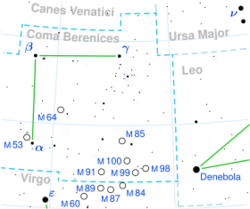Astronomy:7 Comae Berenices
| Observation data Equinox J2000.0]] (ICRS) | |
|---|---|
| Constellation | Coma Berenices |
| Right ascension | 12h 16m 20.53831s[1] |
| Declination | +23° 56′ 43.4700″[1] |
| Apparent magnitude (V) | 4.93[2] |
| Characteristics | |
| Evolutionary stage | red clump[3] |
| Spectral type | G8 III–IIIb[4] |
| B−V color index | 0.957[2] |
| Astrometry | |
| Radial velocity (Rv) | −27.89±0.13[5] km/s |
| Proper motion (μ) | RA: −26.55[1] mas/yr Dec.: −6.22[1] mas/yr |
| Parallax (π) | 13.08 ± 0.30[1] mas |
| Distance | 249 ± 6 ly (76 ± 2 pc) |
| Absolute magnitude (MV) | +0.51[2] |
| Details[5] | |
| Mass | 2.37±0.16 M☉ |
| Radius | 10.07±0.66 R☉ |
| Luminosity | 63+14 −12 L☉ |
| Surface gravity (log g) | 2.95±0.08 cgs |
| Temperature | 5,023±25 K |
| Metallicity [Fe/H] | −0.09±0.05 dex |
| Rotational velocity (v sin i) | 2.26±0.45 km/s |
| Age | 730±150 Myr |
| Other designations | |
| Database references | |
| SIMBAD | data |
7 Comae Berenices is a single[7] star located 249[1] light years away in the northern constellation of Coma Berenices. It is a dim star but visible to the naked eye near the Coma Star Cluster with an apparent visual magnitude of 4.93.[2] The star is moving closer to the Earth with a heliocentric radial velocity of −28 km/s,[5] and is predicted to come as close as 83 light-years in 2.4 million years.[2]
This is an evolved giant star with a stellar classification of G8 III–IIIb.[4] At the age of 730 million years it is a red clump giant, which indicates it is on the horizontal branch and is generating energy via helium fusion at its core.[3] The star has 2.4 times the mass of the Sun and has expanded to 10 times the Sun's radius. It is radiating about 63 times the Sun's luminosity from its enlarged photosphere at an effective temperature of 5,023 K.[5]
References
- ↑ 1.0 1.1 1.2 1.3 1.4 1.5 van Leeuwen, F. (2007), "Validation of the new Hipparcos reduction", Astronomy and Astrophysics 474 (2): 653–664, doi:10.1051/0004-6361:20078357, Bibcode: 2007A&A...474..653V.
- ↑ 2.0 2.1 2.2 2.3 2.4 Anderson, E.; Francis, Ch. (2012), "XHIP: An extended hipparcos compilation", Astronomy Letters 38 (5): 331, doi:10.1134/S1063773712050015, Bibcode: 2012AstL...38..331A.
- ↑ 3.0 3.1 Mishenina, T. V. et al. (September 2006), "Elemental abundances in the atmosphere of clump giants", Astronomy and Astrophysics 456 (3): 1109–1120, doi:10.1051/0004-6361:20065141, Bibcode: 2006A&A...456.1109M.
- ↑ 4.0 4.1 Keenan, Philip C.; McNeil, Raymond C. (1989), "The Perkins catalog of revised MK types for the cooler stars", Astrophysical Journal Supplement Series 71: 245, doi:10.1086/191373, Bibcode: 1989ApJS...71..245K.
- ↑ 5.0 5.1 5.2 5.3 Jofré, E. et al. (2015), "Stellar parameters and chemical abundances of 223 evolved stars with and without planets", Astronomy & Astrophysics 574: A50, doi:10.1051/0004-6361/201424474, Bibcode: 2015A&A...574A..50J.
- ↑ "7 Com". SIMBAD. Centre de données astronomiques de Strasbourg. http://simbad.u-strasbg.fr/simbad/sim-basic?Ident=7+Com.
- ↑ Eggleton, P. P.; Tokovinin, A. A. (September 2008), "A catalogue of multiplicity among bright stellar systems", Monthly Notices of the Royal Astronomical Society 389 (2): 869–879, doi:10.1111/j.1365-2966.2008.13596.x, Bibcode: 2008MNRAS.389..869E.
 |

